Vatican City is one of the most unique places you can visit. It’s the smallest country in the world and home to some of the most famous religious and artistic sites, including the Sistine Chapel and St. Peter’s Basilica.
Whether you’re interested in history, art, or just curious to see what it’s like, this guide will help you prepare for your visit with clear, practical tips. You’ll learn what to wear, how to get there, what to expect at the main attractions, and how to avoid common mistakes.
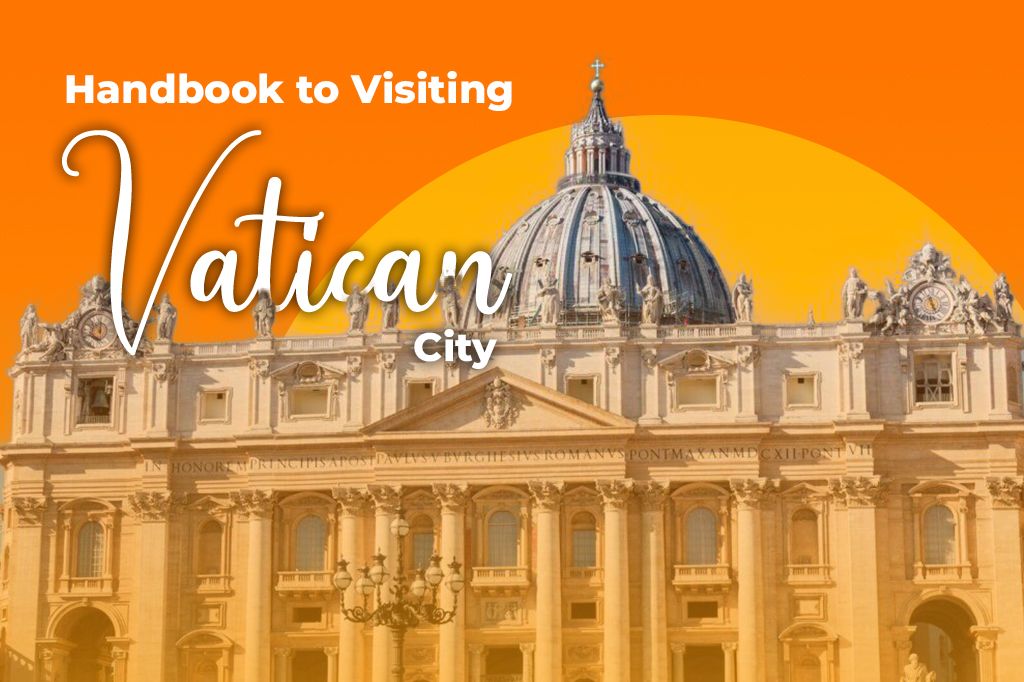
Photo by Martijn Vonk on Unsplash
Before You Go: Know the Essentials
Do I need a passport or visa to visit Vatican City?
Yes, most travelers will need a valid passport to enter Italy, which is the gateway to Vatican City. If you’re from the EU or the Schengen Area, a national ID card may suffice. Vatican City does not issue its own visas, so your entry is based on your permission to enter Italy.
Does the Vatican have its own border checks?
No. There are no customs or immigration checkpoints between Rome and Vatican City. Once you’re in Italy legally, you can enter the Vatican without additional documentation.
What’s the difference between entering the Vatican and just visiting St. Peter’s Square?
St. Peter’s Square is open to the public and doesn’t require a ticket or ID. However, entering sites like the Vatican Museums, Sistine Chapel, or St. Peter’s Basilica involves security checks and may require a pre-booked ticket and ID for pickup.
What should I wear when visiting the Vatican?
You must cover your shoulders and knees. Avoid sleeveless tops, short shorts, miniskirts, and low-cut or see-through clothing. T-shirts are fine if they’re not offensive. Hats must be removed before entering religious buildings.
Are closed shoes required?
No. Most footwear is allowed, including sandals. Flip-flops and beachwear are discouraged, but not strictly banned.
What happens if I don’t follow the dress code?
You may be denied entry. Guards often turn visitors away if they’re dressed inappropriately. Security staff may also require you to buy or wear a cover-up like a scarf or shawl from nearby vendors.
What’s the easiest way to reach the Vatican by public transport?
The metro stations Ottaviano-San Pietro and Cipro (Line A) are closest. Buses 40, 64, 49, 32, 81, and 982 also stop nearby. Tram 19 and the Roma San Pietro train station are additional options.
How do I get there from the airport?
From Fiumicino Airport, take a train to Roma Trastevere, then transfer to Roma San Pietro. Taxis have a fixed rate (around €55) to the Vatican. Shuttle buses also operate between the airport and the Vatican area.
How to stay connected in Vatican City?
Roaming fees can be outrageous, and finding a local SIM at the airport or train station is often overpriced and time-consuming. You can try Yoho Mobile’s free eSIM trial and get instant access to data while you explore the Vatican. You can install it in minutes, even before your flight, and enjoy high-speed data across Italy and most of Europe. No contracts, no lines, no physical SIM cards. Use code YOHO12 if you decide to get a full plan later for an exclusive 12% discount.
Should I take a taxi or public transport?
Public transport is cheaper and avoids traffic, but it can be crowded and requires walking. Taxis are more convenient with luggage but cost more and can face delays. Always use official white taxis with meters to avoid scams.
Are there safety concerns near Vatican entrances?
Yes, pickpocketing is common, especially on bus 64 and near Termini Station. Keep belongings secure. Also, avoid unofficial taxis and street vendors offering tours or souvenirs aggressively.
When is the Vatican most crowded?
From April to October, especially June to August. Mondays and weekends are also busy due to other museum closures in Rome. Expect long lines starting as early as 7:30 AM.
When is it least crowded?
Tuesday to Friday mornings from November to March (excluding holidays) are generally the quietest. Late afternoons and Friday nights (April–October) are also good options, thanks to extended museum hours.
Are skip-the-line tickets worth it?
Yes, especially during peak season or midday hours when lines are long. Skip-the-line or early-access tours reduce waiting time and improve the experience. In low season or late afternoons, their benefit may be less significant.
The Main Attractions in the Vatican
Vatican Museums
The Vatican Museums are huge: 54 galleries packed with around 20,000 artworks from a much larger collection. It’s all laid out across two main floors and a basement, and most people finish their visit at the famous Sistine Chapel. Because of the size and how busy it gets, it really helps to plan your route in advance.
The entrance is on the north side of Vatican City, on Viale Vaticano. Once inside, you can either follow the standard path or take shortcuts to get to the highlights faster. The galleries are grouped by theme and time period, like Egyptian, Etruscan, Roman, Renaissance, and modern collections. You’ll also find practical things like restrooms, elevators, info desks, and a cafeteria mostly on the first floor.
Some parts of the museums are easy to miss but totally worth it. The Gallery of Maps is a beautiful hallway with 40 giant frescoed maps of Italy from the 1500s. The Raphael Rooms, painted by Raphael and his team, are full of stunning Renaissance art and usually less crowded than the Sistine Chapel. There’s also the Borgia Apartments, which mix religious art with more modern pieces, and the Carriage Pavilion in the basement, which shows off old papal carriages and vehicles.
If you’re short on time, you can skip smaller collections like the Gregorian Egyptian Museum or the Ethnological Museum. The Pinacoteca (the painting gallery) and Christian Museum are also pretty large and can be skipped if you’re doing a quick visit.
If you only have 2 hours, stick with the main highlights: go through the Gallery of Candelabra, Gallery of Tapestries, Gallery of Maps, visit the Raphael Rooms, and then head straight to the Sistine Chapel. If you’ve got 4 hours, you can add more stops like the Pio Clementino Museum, Borgia Apartments, and the Carriage Pavilion. Having a map and a basic plan makes a big difference in getting the most out of your visit.
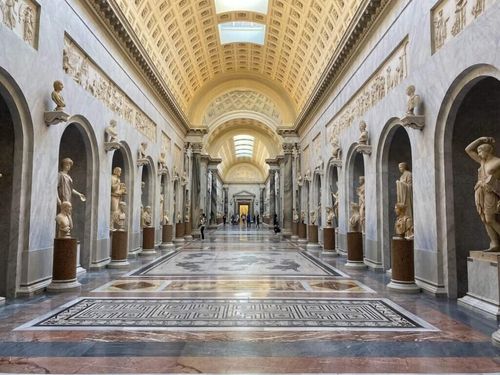
Photo by Corey Buckley on Unsplash
Sistine Chapel
You’re not allowed to take photos or videos inside the Sistine Chapel. The original reason was a deal with a Japanese TV network in the 1980s that helped fund the restoration in exchange for exclusive photo rights. That deal ended in the ’90s, but the Vatican kept the rule. Why? It helps protect the artwork from flash damage and keeps the space respectful. Security guards will ask you to delete photos if they catch you.
To really take in the experience, pause for a moment when you walk in. Look up slowly to absorb the ceiling first, then make your way to the west wall to see Michelangelo’s The Last Judgment. It’s usually packed inside, and visitors are expected to keep moving after a short time.
Michelangelo painted the ceiling between 1508 and 1512, including famous scenes from Genesis, like The Creation of Adam. He worked mostly alone and painted more than 300 figures; his use of bold colors and dramatic poses was way ahead of his time. Later, between 1536 and 1541, he painted The Last Judgment on the wall behind the altar. This caused some controversy because of the nude figures and intense scenes of judgment. After his death, parts were covered with drapery by other artists at the Church’s request. Still, the piece is incredibly powerful and helped change the direction of Renaissance art.
For the best view of The Last Judgment, stand in the middle of the aisle, about halfway between the entrance and the altar. This spot gives you a full view of the whole wall. If you move closer, you’ll see more detail in the lower part. If you stand farther back, you get a wider perspective.
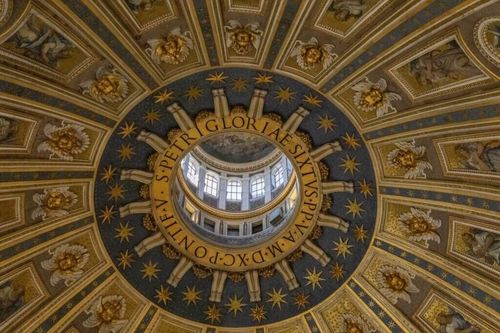
Photo by Leandro Silva on Unsplash
Vatican Gardens
The Vatican Gardens aren’t open for wandering around on your own. You can only visit through a guided tour or an audio-guided open-bus tour. This rule is in place to protect the area and keep it organized and secure. Tours are available in different languages and last anywhere from 45 minutes (on the bus) to about 2 hours (on foot). You’ll need to book your ticket in advance, and that same ticket also gives you access to the Vatican Museums and Sistine Chapel afterward.
What makes these gardens special is how much history and variety they hold. They take up nearly half of Vatican City and include Renaissance, Baroque, and English-style landscaping. Along the way, you’ll see religious monuments, papal residences, fountains, sculptures, and buildings like the House of the Pope Emeritus, Vatican Radio, the Academy of Sciences, and the old summer residence of the Pope. Unlike other European palace gardens, which are more public and recreational, these are still part of the Vatican’s active life.
Tours run every day except Sundays and religious holidays. Audio guides are available in many languages. You’ll need to dress appropriately and wear comfortable walking shoes. Note that kids under six aren’t allowed on the bus tour. Tickets are non-refundable and must be booked ahead of time. After your garden tour, you can go straight into the museums and chapel without waiting in line.
Are the gardens worth the extra fee? If you’re looking for a peaceful break from the crowded museums and basilica, then yes. The bus tour is great if you’re short on time or have limited mobility, while the walking tour gives you more time to soak in the atmosphere. It’s a good option if you want a complete Vatican experience in one day, since the same ticket covers the gardens, museums, and Sistine Chapel.
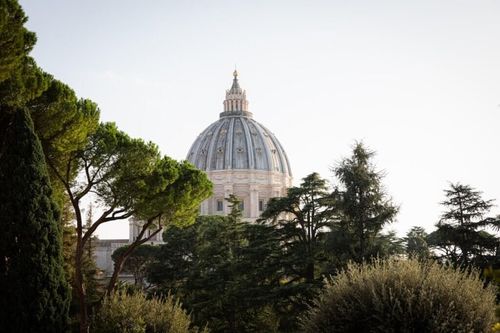
Photo by Christian Lendl on Unsplash
Insider Tips for a More Meaningful Visit
-
Vatican City is the world’s smallest independent country, created in 1929 by the Lateran Treaty. Its sovereignty is unique because it’s tied to the Holy See, the Catholic Church’s governing body led by the Pope. It controls its own territory and governance, separate from Italy, and has diplomatic relations through the Holy See.
-
You can attend Papal Audiences on Wednesday mornings, which are free but require tickets. Request tickets from the Papal Household Prefecture or collect them at the Bronze Door near St. Peter’s Basilica. Swiss Guards may give tickets the day before or morning of the event. No tickets needed for the Sunday Angelus. Arrive early for good seats.
-
The Vatican Museums have well-marked restrooms throughout, including accessible facilities, baby changing stations, and a nursing room. Benches and seating areas are spaced along the route so visitors can rest during the tour.
-
Children can enjoy the Vatican Museums with family-friendly tours, treasure hunts, and stroller access. Highlights include the Carriage Pavilion and outdoor spaces. Bring snacks, water, a map, and something to keep kids entertained, like a notepad or tablet. Pre-book meals to avoid long lines. Guided family tours and workshops are available.
-
During Holy Week or Christmas, crowds are larger, especially for Papal events. Dress codes are strict, and security is tighter; no large bags are allowed. Museums close on Easter Sunday and Monday. Many events require early arrival, and tickets sell out fast. Plan ahead and book tickets early. Most Rome attractions stay open but may have altered hours.
-
Guided tours are great for first-timers and history lovers, offering expert commentary, skip-the-line access, and structure. Self-guided tours cost less, let you explore freely, and are good for budget travelers. Choose based on your priorities: flexibility, depth, or price.
-
Official Vatican tours include skip-the-line access and expert guides. Some private tours offer early entry, art historians, or access to restricted areas like the Vatican Gardens or Niccoline Chapel.
-
Guided tours cost about €30–€40 more but include extras like fast entry and in-depth info. They move at a set pace. Self-guided tours are cheaper but need planning and may lack context unless you use audio guides.
-
Eating near the Vatican? Try Il Segreto, Dino e Toni, Romanè, or Gabrini for Roman pasta and local dishes. For snacks, go to Forno Cresci, La Nicchia Café, or Trionfale Market. Gelato lovers should visit Gelateria dei Gracchi. La Pergola offers formal dining and panoramic views. Cafés on Via della Conciliazione have dome views but are pricey. Budget-friendly trattorias like Dino e Toni or Romanè are nearby on side streets.
-
Bakeries and cafés open 7 AM–12 AM. Restaurants serve lunch from 12–3 PM and dinner from 7–11 PM. Gelato shops stay open late. Avoid places with touts or multilingual signs; locals skip those.
-
Hidden chapels like the Niccoline Chapel and Chapel of St. Peter Martyr are missed by most. These areas feature beautiful Renaissance art and are usually only part of special or VIP tours.
-
The Vatican Post Office near St. Peter’s Basilica uses its own stamps and postmark. Tourists and locals use it to send Vatican-marked mail, distinct from the Italian postal service.
-
The Chapel of the Blessed Sacrament in St. Peter’s is peaceful and for silent prayer. The Vatican Gardens and Vatican Grottoes also offer quiet places for rest and reflection.
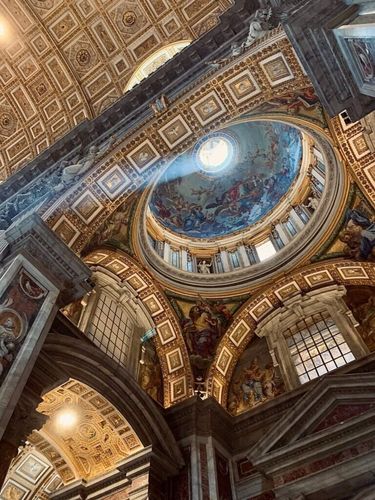
Photo by Ariel Leek on Unsplash
